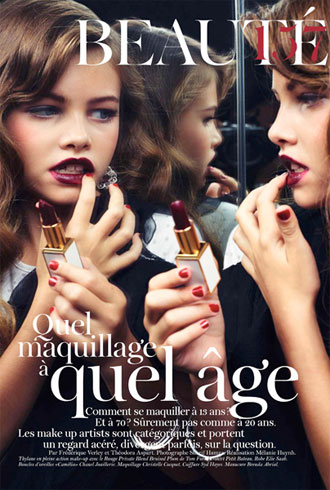One of the most contentious issues in the media sphere today is the concern of the inappropriate sexualisation of youth, regardless of the deliberate intention of the portray-er or in some cases the child themselves. An array of practitioners and average citizens such as parents of young children and teens face an inevitable chopping block when they use children as their muse or medium, albeit for art, advertising or personal consumption.
The question is, are we over-sexualising our children or are such art forms or everyday presentations too harshly critiqued? It cannot be denied that children are an essential marketing tool in a boisterous economy, accounting for billions in the modern market. As stated by Brian Young in David Marshall’s ‘Understanding Children as Consumers’ states “Advertising is pervasive in the culture of the twenty-first century and indeed it would be hard to identify a country on earth that doesn’t have some form of advertising,” but “do children understand advertising the same way as adults?” and if so is this a positive or negative? Undoubtedly younger children and teens are more greatly exposed to advertising than every before due to increase accessibility and frequency of media exposure. Yet if a child witnesses a photograph of a young girl in a provocative pose clothed seductively and plastered in makeup do they see this immoral and strangely disconcerting or simply as a playful afternoon rifling through mums’ things. Perhaps it is a case if adult vs.child interpretation, yet even so it cannot be denied such images circulating in social media and advertising have some influence upon how young girls believe they should dress and act.
The case of French model and actress Thylane Blondeau, daughter of footballer Patrick Blondeau and Véronika Loubry, an actress and television presenter provoked anxiety in the media and public as the young socialite emerged at the sheer age of four modelling for prominent French designer Jean Paul Gaultier. However real controversy arose surrounding the young beauty when at the mere age of nine she ignited a moral panic concerning the over sexualisation of children predominately in advertising and the media as she appeared in the Vogue Paris supplement, Vogue Enfants, poised seductively in somewhat erotic clothing with a heavy face of makeup the socialite was branded “the new Kate Moss”, who too provoked discontent with similar scandalous advertisements. The shoot spiked condemnation from the prominent public figures such as labour MP Helen Goodman claiming the shoot to be ‘disgraceful and totally irresponsible’ by publishing the pictures, saying the editors of the magazine “should have known better.”

Blondeau’s mother, a poster figure for the twenty first century liberal woman spoke out against criticism at the time claiming her daughters’ photographs were progressive not overtly sexual or provocative in any sense. Yet it cannot be contended that the young girl is exhibited in a setting far beyond her years sporting overly mature and revealing, even sexy clothing while sporting an unnaturally erotically aggressive facial expression for such a young girl. All these factors contradict the natural instincts and appearance of an average nine-year-old girl and exemplify the anxieties raised by so many surrounding the prominent issue.

While it can be argued the way in which children are perceived in advertisements remains in the eyes of the beholder it is explicit we are no longer living in an age of innocence as children are exposed to ever-increasingly sexualised content through advertising and other media platforms and while they may not truly understand such confronting images they are subject to inapt and inaccurate representations of childhood and exploitation through their presence in such advertisements.
– Yours, Cat. D


